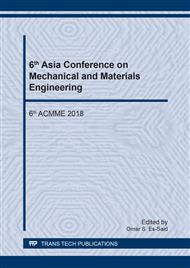[1]
J. Kraxner, J. Chovanec, K. Haladejova, I. Petrikova, D. Galusek, Hollow polycrystalline YAG microspheres by flame synthesis, Mater. Letts. 204 (2017) 181-183.
DOI: 10.1016/j.matlet.2017.05.108
Google Scholar
[2]
R. Marder, C. Estournes, G. Chevallier, Spark and plasma in spark plasma sintering of rigid ceramic nanoparticles:A model system of YAG, J. Eur. Ceram. Soc. 35 (2015) 211-218.
DOI: 10.1016/j.jeurceramsoc.2014.08.001
Google Scholar
[3]
V. Amarantov, N.M. Khamaletdinova, R.P Yavetskiy, Colloid chemical properties of binary sols as precursors for YAG optical ceramics, Ceram. Int. 42 (2016) 17571-17580.
DOI: 10.1016/j.ceramint.2016.08.071
Google Scholar
[4]
S. Hu, C. Lu, X. Liu, Z Xu, Optical temperature sensing based on the luminescence from YAG:Pr transparent ceramics, Optic. Mater. 60 (2016) 394-397.
DOI: 10.1016/j.optmat.2016.08.026
Google Scholar
[5]
A. Katz, E. Barraud, S. Lemonnier, E. Sorrel, A. Leriche, Role of LiF additive on spark plasma sintered transparent YAG ceramics, Ceram. Int. 43 (2017) 15626-15634.
DOI: 10.1016/j.ceramint.2017.08.119
Google Scholar
[6]
H.M. Wang, Z.Y. Huang, J.S. Jiang, Unique mechanical properties of nano-grained YAG transparent ceramics compared with coarse-grained partners, Mater. Design. 105 (2016) 9-15.
DOI: 10.1016/j.matdes.2016.04.094
Google Scholar
[7]
A. Poulia, P.M. Sakkas, D.G. Kanellopoulou, G. Sourkouni, C. Legros, Chr. Argirusis, Preparation of metal–ceramic composites by sonochemical synthesis of metallic nano-particles and in-situ decoration on ceramic powders, Ultrason. Sonochem. 31 (2016).
DOI: 10.1016/j.ultsonch.2016.01.031
Google Scholar
[8]
J.H Xu, K. Bandyopadhyay, D. Jung, Experimental investigation on the correlation between nano-fluid characteristics and thermal properties of Al2O3 nano-particles dispersed in ethylene glycol-water mixture, Int. J. Heat Mass Trans. 94 (2016).
DOI: 10.1016/j.ijheatmasstransfer.2015.11.056
Google Scholar
[9]
J.Y. Xu, B.L. Zou, S.Y. Tao, M.X. Zhang, X.Q. Cao, Fabrication and properties of Al2O3-TiB2-TiC/Al metal matrix composite coatings by atmospheric plasma spraying of SHS powders, J.Alloy. Compd. 672 (2016) 251-259.
DOI: 10.1016/j.jallcom.2016.02.116
Google Scholar
[10]
J.G. Song, F. Wang, M.H. Xu, Effect of synthesis conditions on the particle size and morphology of YAG powder, J. Ceram. Process. Res. 13 (2012) 154-157.
Google Scholar
[11]
T.Y. Zhou, L. Zhang, S. Wei, L.X. Wang, Q.T. Zhang, MgO assisted densification of highly transparent YAG ceramics and their microstructural evolution, J. Eur. Ceram. Soc. 38 (2018) 687-693.
DOI: 10.1016/j.jeurceramsoc.2017.09.017
Google Scholar
[12]
G.Q. Xie, D.V.L. Luzgin, F. Wakai, H. Kimura, A. Inoue, Microstructure and properties of ceramic particulate reinforced metallic glassy matrix composites fabricated by spark plasma sintering, Mater. Sci. Eng. B 148 (2008) 77-81.
DOI: 10.1016/j.mseb.2007.09.027
Google Scholar
[13]
M.H. Xu, J.G Song, D.M. Du, F. Wang, Y.L Li, G.C Ji, F. Chen, The mechanism of controlling pore microstructure for YAG porous ceramics, Key Eng. Mater. 680 (2016) 216-219.
DOI: 10.4028/www.scientific.net/kem.680.216
Google Scholar
[14]
J.Z. Zhao, Y. Li, Y. Wu, S. Lv, K. Lu, Microstructure of TiO2 porous ceramics by freeze casting of nanoparticle suspensions, Ceram. Int. 43 (2017) 14593-14598.
DOI: 10.1016/j.ceramint.2017.06.134
Google Scholar
[15]
L.C. Hwa, S. Rajoo, A.M. Noor, N. Ahmad, M.B. Uday, Recent advances in 3D printing of porous ceramics: A review, Curr. Opin. Solid State Mater. Sci. 21 (2017) 323-347.
DOI: 10.1016/j.cossms.2017.08.002
Google Scholar
[16]
M. Rahmani, O. Mirzaee, M. Tajally, The effects of pH and excess Al3+ content on the microstructure and phase evolution of YAG polycrystals, Ceram. Int. 43 (2017)12563-12571.
DOI: 10.1016/j.ceramint.2017.06.131
Google Scholar
[17]
X.H. Su, J. Zhou, G. Bai, Low temperature synthesis and characterization of YAG nanopowders by polyacrylamide gel method, Ceram. Int. 42 (2016) 17497-17502.
DOI: 10.1016/j.ceramint.2016.08.058
Google Scholar
[18]
S. Bera, C.D. Nie, M.G. Soskind, Growth and lasing of single crystal YAG fibers with different Ho3+ concentrations, Optic. Mater. 75 (2018) 44-48.
DOI: 10.1016/j.optmat.2017.09.048
Google Scholar


